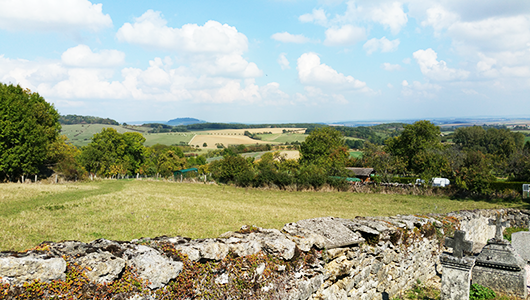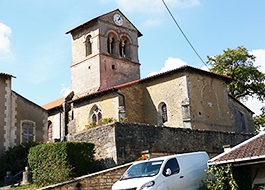Battigny
Durée visite : 20 minutes
Moyen : Pédestre
Battigny est un charmant village à flanc de coteau. Une ancienne maison-forte médiévale se trouve rue de L’Eglise. Elle côtoie un lavoir. Le presbytère du XVIIe siècle jouxte l’église Saint-Germain. Depuis ces édifices, un beau point de vue s’offre aux visiteurs. Antoni Moreau est né en 1837 à Battigny. Il est mort en 1903. Il fut brasseur à Vézelise et Saint-Nicolas-de-Port.
Battigny is a charming village on the hillside. An old medieval stronghold is located rue de L’Eglise. It is next to a wash house. The 17th century presbytery adjoins Saint-Germain church. From these buildings, a beautiful view is offered to visitors. Antoni Moreau was born in Battigny in 1837. He died in 1903. He was a brewer in Vézelise and Saint-Nicolas-de-Port.
Battigny ist ein charmantes Dorf am Hang. Eine alte mittelalterliche Festung befindet sich in der Rue de L’Eglise. Es liegt neben einem Waschhaus. Das Presbyterium aus dem 17. Jahrhundert grenzt an die Saint-Germain-Kirche. Von diesen Gebäuden aus wird den Besuchern eine schöne Aussicht geboten. Antoni Moreau wurde 1837 in Battigny geboren. Er starb 1903. Er war Brauer in Vézelise und Saint-Nicolas-de-Port.

Burelé d’argent et de sable de 10 pièces, à la bande de gueules chargée de trois abeilles d’or.
Au siècle dernier, il y avait à Battigny une quinzaine d’apiculteurs qui vivaient du produit des abeilles, non seulement du miel, mais aussi de la cire pour fabriquer des cierges. C’est pourquoi trois abeilles en bande chargent le burelé de Vaudémont pour souligner que Battigny fait partie de ce comté. Quant à la bande, elle rappelle bien sûr la Lorraine.
Burelé Argent and Sable of 10 pieces, with a bend Gules charged with three bees of gold.
In the last century, there were around fifteen beekeepers in Battigny who lived off the produce of bees, not only honey, but also wax to make candles. This is why three bees in a band load the burelé de Vaudémont to emphasize that Battigny is part of this county. As for the band, it is of course reminiscent of Lorraine.
Burelé Argent und Sable von 10 Stück, mit einer Biegung Gules mit drei Bienen aus Gold aufgeladen.
Im letzten Jahrhundert gab es in Battigny etwa fünfzehn Imker, die von Bienenprodukten lebten, nicht nur von Honig, sondern auch von Wachs, um Kerzen herzustellen. Aus diesem Grund laden drei Bienen in einer Band das Burelé de Vaudémont, um zu betonen, dass Battigny Teil dieser Grafschaft ist. Die Band erinnert natürlich an Lothringen.

Les habitants et les habitantes de Battigny sont appelés les Battigniens et les Battigniennes
The inhabitants of Battigny are called the Battigniens and the Battigniennes.
Die Einwohner von Battigny heißen Battigniens und Battigniennes.
Les points de visites
.
A Battigny existe une belle église romane. Elle domine toujours les toits, depuis le coteau légèrement escarpé. Bâtie dans la seconde moitié du XIIe siècle, l’église Saint-Germain est, en partie entourée par le cimetière. Quelques tombes anciennes ont été préservées. Appartenant au diocèse de Toul, doyenné du Saintois, ce sanctuaire était une annexe de l’église de Puxe. Les dîmes relevaient de l’abbaye vosgienne de Belval. A la fin du XVe siècle, l’officiant de Battigny est désigné par le chapitre de Vaudémont et les moines de Nancy, les successeurs de Belval. Au XVIe siècle, la base du clocher est reprise. Des fresques, où figure notamment Saint-Nicolas, sont peintes sur les murs de la nef unique. Celles-ci ont été redécouvertes en 2009. Elles ont été restaurées dans la foulée grâce à la Fondation du Patrimoine.
In Battigny there is a beautiful Romanesque church. It still dominates the roofs, from the slightly steep hillside. Built in the second half of the 12th century, the Saint-Germain church is, partly surrounded by the cemetery. Some ancient graves have been preserved. Belonging to the diocese of Toul, deanery of Saintois, this sanctuary was an annex to the church of Puxe. Tithes were the responsibility of the Vosges abbey of Belval. At the end of the 15th century, the officiant of Battigny was appointed by the chapter of Vaudémont and the monks of Nancy, the successors of Belval. In the 16th century, the base of the bell tower was taken over. Frescoes, including Saint-Nicolas, are painted on the walls of the single nave. These were rediscovered in 2009. They were immediately restored thanks to the Heritage Foundation.
In Battigny gibt es eine schöne romanische Kirche. Es dominiert immer noch die Dächer, vom leicht steilen Hang. Die in der zweiten Hälfte des 12. Jahrhunderts erbaute Saint-Germain-Kirche ist teilweise vom Friedhof umgeben. Einige alte Gräber sind erhalten geblieben. Dieses Heiligtum gehörte zur Diözese Toul, dem Dekanat von Saintois, und war ein Nebengebäude der Kirche von Puxe. Der Zehnte lag in der Verantwortung der Vogesenabtei von Belval. Ende des 15. Jahrhunderts wurde der Offizier von Battigny vom Kapitel von Vaudémont und den Mönchen von Nancy, den Nachfolgern von Belval, ernannt. Im 16. Jahrhundert wurde die Basis des Glockenturms übernommen. Fresken, einschließlich des Heiligen Nikolaus, sind an die Wände des einzelnen Kirchenschiffs gemalt. Diese wurden 2009 wiederentdeckt. Dank der Heritage Foundation wurden sie sofort restauriert.
.






